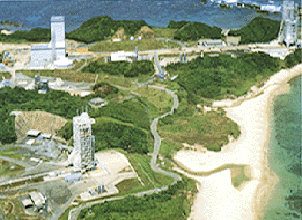

The National Space Development Agency of Japan (NASDA) is in the process of assembling a new domestically produced rocket, the J-1. Scheduled to be launched from the Tanegashima Space Center in February 1996, the J-1 features a cost-efficient design that incorporates parts of existing rockets. It will carry as its payload an experimental space vehicle that will gather data to be used in the development of a Japanese space shuttle, HOPE.
The mainstay of Japan's space program is today the H-2, the first of which was successfully launched in 1994. The H-2, which can boost a two-ton satellite into geostationary orbit 36,000 kilometers above the equator, is a two-stage rocket fueled by liquid oxygen and liquid hydrogen. The J-1, on the other hand, is a three-stage rocket designed to place a satellite of about one ton in low orbit. It was jointly developed by NASDA and the Ministry of Education's Institute of Space and Aeronautical Science with an eye to a likely increase in the demand for rockets to put into low orbit small telecommunications and other satellites.
To save on development and production costs, current plans call for the first J-1 to incorporate the type of solid-fuel rocket now being used by NASDA as boosters for the H-2; the second and third will use a combination of the M23 and M3B sold-fuel rockets that constitute the tip of ISAS's M-3SII. The J-1, which stands 33 meters tall, measures 1.8 meters in diameter, and weighs 87 tons is rather small compared to the H-2-50 meters tall, 4 meters in diameter, 264 tons-but was developed for only one-ninth of the cost, or 3.1 billion.
The first J-1, scheduled to be launched on February 1, 1996, will carry as its payload the 1,050-kilogram HYFLEX, a hypersonic flight experiment vehicle that will collect data for the development of a Japanese space shuttle, named HOPE. HYFLEX will separate from the J-1 at an altitude of 110 kilometers and glide back through the atmosphere. Scientists will be evaluating such points as HYFLEX's heat-resistant properties as it reaches temperatures as high as 1500-1600 degrees Celsius and its stability and control systems as it hits speeds of up to Mach 15. After completing its glide, the HYFLEX will deploy a parachute and splash down in the ocean near the island of Ogasawara, where it will be retrieved by waiting ships
(The above article, edited by Japan Echo Inc., is based on domestic Japanese news sources. It is offered for reference purposes and does not necessarily represent the policy or views of the Japanese Government.)